Strawberry Pests and Diseases: Complete Guide with Images
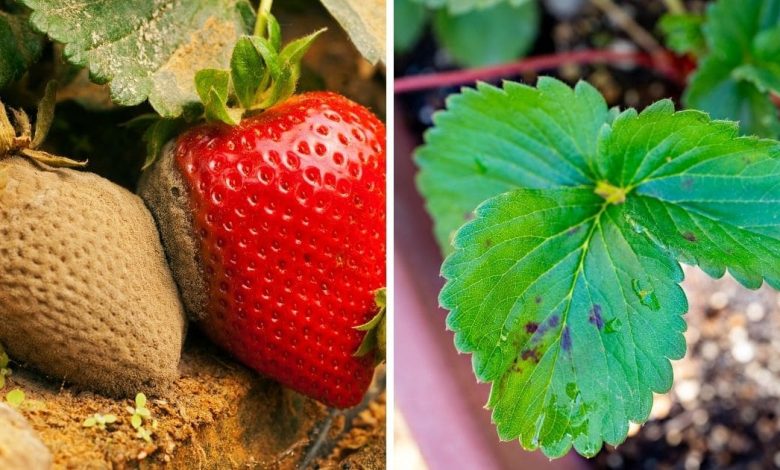
Hello to all agrohuerters! In today’s article we will see what the main strawberry pests and diseases are and how to control them. To do this, we will first talk about strawberry pests and then about diseases caused by fungi or other microorganisms.
Sometimes you can also hear the word strawberry. The most characteristic difference between strawberries and strawberries is that the former have a much smaller size and volume than the strawberry. On the other hand, the flavor of the strawberry is usually sweeter and the strawberry more acidic. In Spain we are great consumers of strawberries and strawberries. The place where this crop is most produced is in Huelva (in the south of Spain).
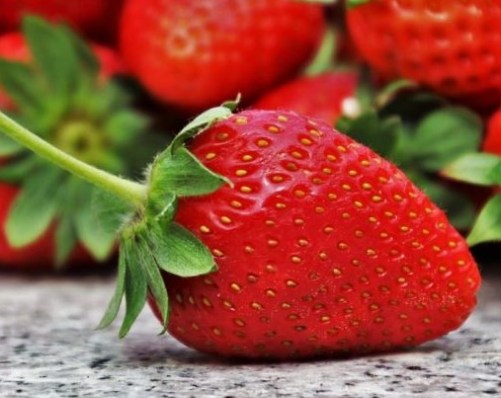
strawberry pests
Various pests can attack the strawberry crop in our orchards or pots. Next we will see which are the most important.
Nematodes in the roots of strawberries
Nematodes, also known as nematodes or roundworms, are a species of worms that live in water and soil. They are usually so small that they cannot be seen with the naked eye. They mainly attack the roots of plants, in this case, strawberries.
Among the most important nematode species that can attack strawberry crops, we can highlight: Aphelenchoides fragariae, Ditylenchus dipsaci or some species of the Pratylenchus genus.
Little bugs in strawberries: mites
In some situations, if we look closely at the leaves of our plants, we can see small bugs known as mites. In the case of strawberries, it is common to find a mite called Tetranychus urticae. One of the main symptoms associated with this species is a grayish color in the leaves of strawberries.
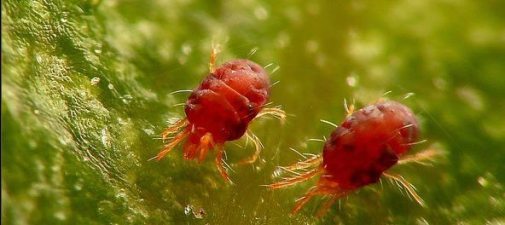
aphids on strawberries
Unlike mites, aphids can be seen well with the naked eye. For this reason, if we look at the leaves of strawberries, we can sometimes see these insects on the upper or lower sides. Among the most common species of strawberry aphids, the yellow aphid stands out. This species, like other aphids, is important because it can transmit viruses to plants.
Although it is less common in strawberry cultivation, we can also find green aphids (Aphis forbesi).
diseases of strawberries
Once we know which are the most important pests that attack strawberry crops, we are going to focus on diseases. The most serious diseases that occur in strawberry cultivation are Verticillium wilt, Botrytis, Anthracnose, Phyththora
Strawberry Leaf Spots
If the spots are located on the leaves and have a brown color, it may be a disease caused by bacteria. For example, by a bacterium known as Xanthomonas fragariae as we can see in this image:
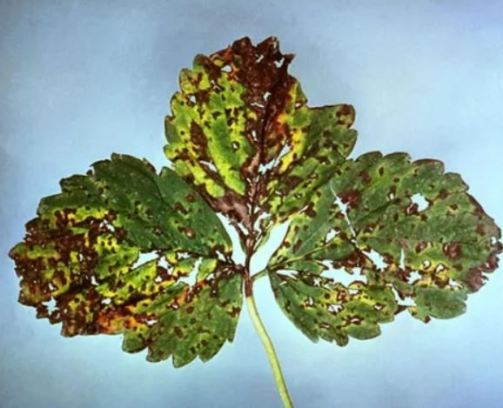
On other occasions it may happen that the edge of the leaves turns yellow. In this case, the culprit may be a virus (transmitted by insects, for example aphids).
If the spots acquire a necrotic effect, it may be a disease due to Alternaria alternata or Zythia fragariae. In the second case, the adult leaves are the first affected.
White powder on strawberries
If we observe a kind of grayish-white powder on the leaves or on the strawberries, it can be one of two things.
In the first place, if the dust is rather white, it will be Powdery Mildew (due to Sphaerotheca macularis). However, if we see that this powder is rather grayish, with a rotten appearance, it will be Botrytis cinerea (Commonly known as » gray rot «). In both cases they are two diseases caused by fungi.
During my studies at the university we did a practice to see what symptoms Botrytis caused. We were also lucky enough to see what this type of fungus is like under the microscope.
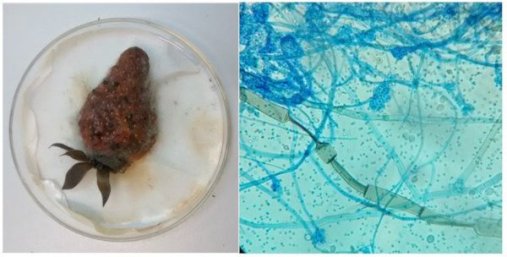
For this reason, whenever we are told about strawberry pests and diseases, Botrytis will be one of the first that comes to mind.
Strawberry Root Diseases
There is a disease caused by a fungus called Armillaria mellea and known as white root rot. This disease produces white filaments on the roots of strawberries and can even cause death.
On the other hand, if the rot is rather black, the cause may be various fungi known as: Rhizoctonia fragariae, Coniothyrium fucckelii or Cylindrocarpon radiccicola. The severity of the action of these fungi will depend on other factors such as: weather conditions, existence of lesions caused by nematodes, etc.
When there is an alternation between necrotic zones and healthy zones and the root zone presents a reddish color, it is known as Phytophthora fragariae.
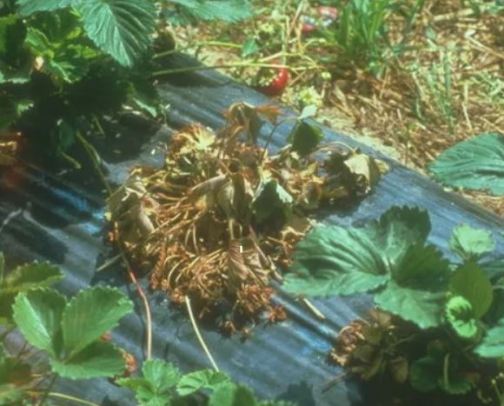
If we observe that the roots are drying out little by little, it may be due to the attack of one of the pests mentioned above. For example: Agriotes sp.(wireworm), Coroebus elatus or Gryllotalpa gryllotalpa.
Strawberry pest and disease control
Once we know all the symptoms and causes of strawberry pests and diseases, we must try to prevent their appearance and learn how to control them. Therefore, below we are going to expose some of the most common solutions to prevent and control them.
- Use pathogen-free seeds. In this way we will prevent our plants from acquiring pathogens from the beginning.
- Do not replant in land that has been contaminated the previous year.
- Burn the remains of the harvest if the plants have been contaminated with a pathogen.
- Avoid sprinkler irrigation. The sprinkler irrigation method favors the spread of many of the garden plant diseases. For them it is better to try watering with other methods such as dripping.
- Promote crop aeration (avoid crops being too close together).
- Remove affected leaves. In this way we will reduce the spread of the disease.
- Avoid varieties sensitive to certain diseases.
- Most chemical methods are not very effective once the disease is in the plant.
- Avoid stagnant water near crops. Good drainage should be encouraged.
- Disinfect the material if we have treated a contaminated culture.
If we comply with all these tips on strawberry pests and diseases, we will be able to grow healthy strawberries and strawberries in our orchards. In addition, you can also learn how to plant strawberries in pots if you go to the following link: How to plant strawberries and strawberries in a pot.
References
- Sutton, JC (1995). 9 Evaluation of micro-organisms for biocontrol: Botrytis cinerea and strawberry, a case study. Advances in Plant Pathology. Academic Press. 11, 173-190.
- Browning M, Wallace DB, Dawson C, Alm SR, Amador JA (2006). Potential of butyric acid for control of soil-borne fungal pathogens and nematodes affecting strawberries. Soil Biology and Biochemistry. 38, 401-404.
- Asalf B, Trandem N, Stensvand A, Wekesa V, Moraes G, Klingen I (2012). Influence of sulfur, powdery mildew, and the predatory mite Phytoseiulus persimilis on two-spotted spider mite in strawberry. Biological Control. 61,121-127.
- Singhalage ID, Seneviratne G, Madawala HMSP, Wijepala PC (2018). Profitability of strawberry (Fragaria ananassa) production with biofilmed biofertilizer application. Scientia Horticulturae. 243, 411-413.
This is all for today, I hope you liked the article and do not hesitate to tell us about your experiences in the comments. See you in the next article!
Have a nice day!

![Photo of Sow Wheat: How, When and Where in [12 Steps + Images]](https://www.complete-gardening.com/wp-content/uploads/2022/08/sow-wheat-how-when-and-where-in-12-steps-images-390x220.jpg)
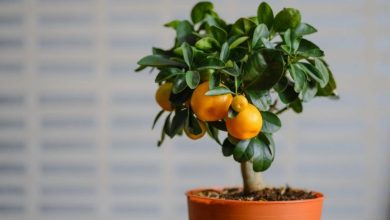

![Photo of The Walnut: [Complete Guide to Grow It Successfully in your Garden]](https://www.complete-gardening.com/wp-content/uploads/2022/08/the-walnut-complete-guide-to-grow-it-successfully-in-your-garden-390x220.jpg)